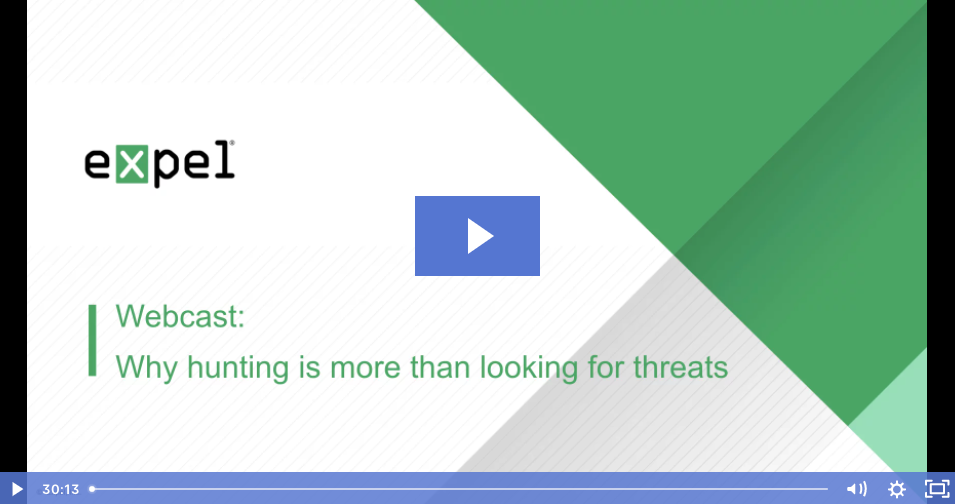Table of Contents
Threat hunting is a proactive cybersecurity approach focused on discovering, identifying, and neutralizing potential threats before they escalate into serious issues. Unlike the reactive method of responding to threat alerts as they arise, threat hunting actively seeks out vulnerabilities and risks. Both approaches share the common goal of preventing hackers from causing significant damage.
Expel MDR thinks about threat hunting in cybersecurity like being a wildlife tracker in a vast digital forest. While traditional security tools function as fences and alarm systems around your perimeter, threat hunters actively venture into the wilderness, looking for subtle signs of predators that have already slipped inside. They study unusual tracks in the data, follow trails of suspicious activity, and recognize the telltale behaviors of different digital predators—all before these threats have a chance to strike. Just as expert trackers can read a broken twig or disturbed soil, skilled threat hunters can spot the faintest indicators of compromise that automated systems might miss.
Many organizations don’t have the resources or expertise to run their own threat-hunting programs. Just as with all cybersecurity programs, the shortage of skilled staff impacts the scale and effectiveness of threat hunting. In the SANS Institute’s 2023 Threat Hunting Survey, 73% of respondents said their organizations need more training or more experienced staff to conduct threat hunting. Managed detection and response (MDR) providers can assist these overwhelmed organizations.
Comparison of hunting vs. alert management
| Hunting | Alert management | |
|---|---|---|
| Service approach | Proactive | Reactive |
| Timeframe | Retrospective | As it happens |
| Data source | Bulk data | Specific security event(s) |
Why is threat hunting valuable?
The most dangerous and successful cyberattacks often start with a stealthy intruder who spends days or even weeks inside an organization’s networks, preparing to execute their objective. Cybersecurity must go on the offensive, not just the defensive. Endpoint defenses alone can’t stop all threats, especially those that have already infiltrated the network. Cybercriminals constantly adapt to bypass security measures and target the system’s weakest links. Therefore, cybersecurity leaders need to anticipate and prevent attacks before they occur.
How does threat hunting work?
These practices are at the core of threat hunting:
Continuous monitoring and visibility
Threat hunting ensures continuous visibility across networks, endpoints, and systems, enabling organizations to detect anomalous behavior and potential threats. This process utilizes real-time monitoring tools, security information and event management (SIEM) systems, and network intrusion detection systems (NIDS) to collect and analyze the vast amounts of data encountered daily by a security operations center (SOC).
As they monitor network traffic, logs, and system activity, threat hunters can set a baseline of normal behavior and identify deviations that can indicate malicious activity. Continuous monitoring helps security teams detect threats earlier, improving the chances of rapid intervention and mitigation.
An intelligence-driven approach
Human analysts are essential to threat hunting, leveraging their experience and instincts to improve cybersecurity efforts. Detecting threats also requires comprehensive data intelligence, both internal and external, including historical attack data, indicators of compromise, and threat feeds. This robust intelligence base enables security professionals to prioritize and focus on the most critical and high-risk threats, ensuring the SOC stays ahead of cybercriminals by identifying potential threats before they can cause damage to the organization.
Hypothesis generation and testing
Testing hypotheses is a crucial aspect of the threat-hunting process. Armed with solid intelligence and the expertise of experienced analysts, threat hunters formulate hypotheses about potential threats or suspicious activities within the environment.
Once a hypothesis is developed, it is tested using data sources, logs, and behavioral analyses from the SOC. Threat hunters scrutinize system artifacts, identify patterns or anomalies, and validate their assumptions. By rigorously testing these hypotheses, they can confirm or refute their suspicions, potentially uncovering malicious activities that might have otherwise gone undetected.
Collaboration and knowledge sharing
Threat hunting is a team sport. It works because different teams collaborate and share information. This includes security operations centers, incident response teams, and threat intelligence units. The process brings together diverse skills, experiences, and perspectives to supercharge the operation. Ongoing communication and information-sharing create a better understanding of the threat landscape, driving faster response times.
Two approaches to threat hunting
In cybersecurity, some industry leaders see threat hunting’s purpose as only to search for problems based on known indicators of compromise (IOCs), as well as data on the tactics, techniques, and procedures (TTPs) used by known attackers. IOC-based threat hunts are an essential part of cybersecurity because they connect to vast amounts of continuously updated, often crowdsourced threat data. IOC hunts are also useful for remediating and responding to related incidents in real time and assessing impact afterwards.
But the IOC approach has limitations. It misses the “unknown unknowns” out there, so it’s not a 100%-effective solution. IOC hunts represent fleeting moments in time and must be continuously refreshed—they’re very much a reactive exercise.
By contrast, the proactive approach to threat hunting is centered on a deep understanding of an organization’s infrastructure and business requirements. Teams focus on assessing, predicting, and even imagining where vulnerabilities might emerge. Hypotheses are formed, threats are defined, and the hunt is on.
Conclusion
Modern threat hunting blends both reactive and proactive security approaches. Rather than just waiting to respond to attacks, organizations must now actively search for threats using a mix of known indicators and creative investigation. Success requires good monitoring tools, threat intelligence, and teamwork. While building these capabilities takes resources and skilled staff, it’s becoming essential for defending against today’s cyber threats—whether addressed in-house or through a security provider.
Video transcript: What is threat hunting in cybersecurity?
We’re here to talk about threat hunting in cybersecurity—what it is, why it matters, and how it actually works. At its core, threat hunting is a proactive approach to detecting threats. Instead of sitting around and waiting for an alert to go off, threat hunters go looking for signs of malicious activity—clues that something may be off in your environment, even if the alarms haven’t sounded yet.
It’s a mix of science, intuition, and detective work. And done right, it helps you catch threats before they escalate into full-blown incidents.
Why traditional alerts aren’t enough
Let’s be honest: most cybersecurity teams are buried in alerts.
Between your SIEM, EDR, firewall logs, and cloud platforms, you’re dealing with an overwhelming volume of signals—most of them noise. But attackers know this. In fact, they rely on it.
They hide in the clutter, exploiting the fact that defenders can’t chase every ping. Threat hunting flips that narrative.
How threat hunting works
It usually starts with a hunch. A weird pattern. A strange spike in network activity. Or just a gut feeling that something isn’t quite right.
From that point, threat hunters form a hypothesis and begin digging—reviewing raw telemetry, behavioral data, and log files to test their theory.
And this isn’t a solo mission. Effective threat hunting involves collaboration between:
-
The security operations center (SOC)
-
Incident response teams
-
Threat intelligence analysts
Each brings a unique perspective, skill set, and experience to the hunt.
Two types of threat hunting
You’ll hear different takes, but threat hunting in cybersecurity typically falls into two categories:
1. IOC-based threat hunting (a.k.a. sweeps)
This is the reactive version. You search for known indicators of compromise (IOCs)—IP addresses, file hashes, malware signatures—often tied to active campaigns. It’s quick and useful, but limited. By the time you detect the IOC, the attacker may already be inside.
2. Hypothesis-driven threat hunting
This is the deeper, slower, more customized approach—what we call capital T, capital H “Threat Hunting.”
It’s not about chasing known threats. It’s about looking for the unknown. At Expel, this is where we shine.
Say a customer tells us something in their environment feels off, but they don’t have proof. We go back 30 days in telemetry. We start asking questions: What’s normal? What’s new? What doesn’t fit?
The goal isn’t just to find the obvious threat. It’s to spot the outlier—the anomaly that might indicate early-stage compromise.
Why this proactive approach matters
Modern attackers aren’t kicking in the front door. They’re not the Kool-Aid Man. They’re subtle. Stealthy. Patient.
They slip in quietly, wait, and move slowly to avoid detection. That’s why you can’t rely solely on alerts. You need a proactive cybersecurity strategy—one that includes hunting as a regular discipline.
It takes persistence, creativity, and—yeah—a little healthy paranoia.
Looking for a threat hunting partner?
At Expel, we do both kinds of threat hunting—IOC sweeps and tailored, hypothesis-driven investigations—as part of our managed detection and response (MDR) service.
Want to see how our team can help you stay ahead of threats?




